King's
College Hospital
Denmark Hill, SE5 9RS
Medical
dates:
Medical
character:
Teaching. Acute
In 1903 the Hon. William
Frederick Danvers Smith (later Lord Hambledon) (1868-1928), a member of
the family firm W.H. Smith, purchased 12 acres of
land in Bessemer Road, Denmark Hill, and presented it to
King's College Hospital.
In 1904 an Act of Parliament was obtained to enable the Hospital
to relocate to south London from its then premises in Portugal Street, Lincoln's Inn Fields.
The foundation stone for the new building was laid by King Edward VII in 1909 and, in the same year, King's College London (KCL) was incorporated into the University of London, while the Hospital was recognised as a separate legal entity. The King's College Hospital Medical School was established; the Faculty of Medical Science remained at KCL in the Strand for pre-clinical training, while the Medical School provided clinical instruction.
In May 1912 an anonymous donor gave £50,000 to the rebuilding project.
In July 1913 the Committee of Management held its last meeting in the Portugal Street premises. This was followed by supper in Wigram Ward for the staff, and former and current medical students of the Hospital.
The new King's College Hospital with 600 beds was officially opened by King George V and Queen Mary on 26th July, 1913. The firm W.H. Smith had paid £1,000 towards the Hospital's relocation costs, with the promise of another sum the following year.
The new Hospital was built in the pavilion style on a north-south axis, with a central administrative block, which also included Matron's department and the Nurses' Home. The six pavilion blocks, each 870 ft (265 metres) in length, were arranged in parallels on the south side of a covered corridor (the plan allowed for nine pavilions, funds permitting). The main wards were each equipped with a kitchen and had a side room for patients needing special care. Westward of the central block were special wards (some of which were circular), the Medical School and the Pathology Department. There were also an isolation block, a chapel and a mortuary.
There were four operating theatres, each of which had anaesthetic and recovery rooms, as well as a gallery from which medical students could observe operations.
Eastward of the central block was a block containing the Out-Patients and Casualty Departments. The large Out-Patients Department could seat 500 people and had a permanent refreshment counter in the centre. As well as X-ray, Dental, Massage and Electrical Departments, there was a Bathing Department which provided treatment by various medical baths. The Children's Department had a separate entrance for patients with whooping cough.
The buildings incorporated many innovations, such as rounded wall, ceiling and floor junctions to prevent dust from gathering in corners. Power for lighting was supplied by diesel engines (which continued in use until 1955). There were also electric clocks. The Hospital had a Siemens-Edison telephone system, the second such internal telephone installation in the United Kingdom.
Within a year, however, WW1 had broken out and a large part of the Hospital was requisitioned by the War Office for use as a military hospital - the Fourth London General Hospital. Only four wards and the Casualty Department remained available for civilian patients.
At first the Fourth London General Hospital contained a few cases of injury and sickness among men in training at various military camps in the country but, as the casualties from France grew, the military hospital was extended into the nearby Ruskin Park. Huts and tents were erected and a wooden bridge built across the railway line to provide access.
In May 1915 Neurological Sections were established in all the Territorial General Hospitals, the largest being that of the Fourth London, which took over the recently built Maudsley Hospital nearby. The Section had 400 beds and received the majority of the neurological cases sent from overseas, as well as patients transferred from central and auxiliary hospitals in the London region and adjoining counties.
By 1917 the Hospital had 369 beds for officers and 169 for enlisted men, including 71 for ENT cases, 28 for skin disorders and 39 for eye injuries. Sixty of the beds were reserved for 20 officers and 40 men receiving Carrel-Dakin treatment (periodic flooding of their infected wounds with an antiseptic solution). The Hospital had been extended into Ruskin Park, where huts had been built to accommodate 656 patients. Two local schools had been requisitioned - the Grove Lane Schools and the Venetian Road Schools - and two large mansions - The Platanes and Osnabruck House. Montpelier House in Ealing and Fairlawn in Forest Hill served as convalescent homes for the Hospital, as did many other auxiliary hospitals.
The Hospital had its own monthly magazine, called The Fourth, which contained prose, poetry and illustrations and cost 3d (just over 1p).
In 1919 the Hospital was demobilised and handed back for civilian use.
During the 1920s new departments were established in diabetes, neurology and antenatal care. A Dental School and Hospital opened in 1923. However, the Hospital's finances, like many other voluntary hospitals, were fraught and, in 1931, several wards had to be closed to save money.
In 1937 a private patients' wing - the Guthrie Wing - opened. It had been paid for by a donation from the Stock Exchange Dramatic and Operatic Society. The Wing had a separate Art Deco entrance, but the wards were small.
In 1938, when the Hospital had 384 beds, the Duchess of Gloucester, its President, visited.
During WW2 the Hospital became a casualty clearing station for air raid victims. Once treated, patients were evacuated to Epsom or Leatherhead. The operating theatres were relocated to the basement, and patients in the higher wards were moved to the basement during bombing raids. Amazingly, apart from incendiary bombs, the Hospital was only hit once by a small bomb, although the local streets were heavily bombed.
The Hospital joined the NHS in 1948 as a teaching hospital group managed by a Board of Governors. The Kings College Hospital Group included the Royal Eye Hospital, the Belgrave Hospital for Children, the Belgrave Recovery Home in Minstead, Hants, and the Baldwin Brown Recovery Home in Camberley, Surrey. In 1966 the Camberwell hospitals - St Giles' Hospital, the Dulwich Hospital and St Francis Hospital - were added to the Group. It was planned to consolidate all the Camberwell hospitals onto the Denmark Hill site.
A new Dental School building was completed in 1965 and, in 1968, a new maternity block (currently the Ruskin Wing).
In 1972 a new building was erected to house the School of Nursing. It opened in 1974 and was named the Normanby College of Nursing, Midwifery and Physiotherapy.
In 1974, following another reorganisation of the NHS, the Hospital became part of the King's Health District (Teaching). The Board of Governors was disbanded and replaced by a District Management Team.
In 1979 the Rayne Institute opened to accommodate various medical research departments of King's College London.
Yet another NHS reorganisation in 1982 resulted in the King's Health District (Teaching) becoming the Camberwell District Health Authority. In 1983 the Medical School was reunited with King's College London to form the King's College School of Medicine and Dentistry.
The Wellcome Clinical Investigation Unit opened in 1990 and, in 1991, an extension was added to the Dental School building, which also housed the Day Surgery Centre. The Weston Education Centre for the Medical School, with a library and lecture theatres opened in 1997. The building also contained the Palliative Care and General Practice Departments. A new Accident and Emergency Department also opened in the same year, replacing the previous one which had become too small for the number of patients being seen daily.
In 1993, after yet another NHS reorganisation, the newly-formed King's Healthcare Trust took over management of the Hospital.
The Caldecot Centre for sexual health opened in 1994.
In 1998 King's College School of Medicine and Dentistry merged with the United Medical and Dental Schools of Guy's and St Thomas' Hospitals. They are now collectively known as the Guy's, King's and St Thomas' School of Medicine (usually shortened to 'GKT').
In 2003 the Golden Jubilee Wing was officially opened by Queen Elizabeth II. It was built on the site of the previous Out-Patients Department and contains clinics, Physiotherapy and Occupational Therapy Departments, and therapy suites for speech and language.
In May 2010 the Princess Royal opened the Cicely Saunders Institute for palliative care.
The foundation stone for the new building was laid by King Edward VII in 1909 and, in the same year, King's College London (KCL) was incorporated into the University of London, while the Hospital was recognised as a separate legal entity. The King's College Hospital Medical School was established; the Faculty of Medical Science remained at KCL in the Strand for pre-clinical training, while the Medical School provided clinical instruction.
In May 1912 an anonymous donor gave £50,000 to the rebuilding project.
In July 1913 the Committee of Management held its last meeting in the Portugal Street premises. This was followed by supper in Wigram Ward for the staff, and former and current medical students of the Hospital.
The new King's College Hospital with 600 beds was officially opened by King George V and Queen Mary on 26th July, 1913. The firm W.H. Smith had paid £1,000 towards the Hospital's relocation costs, with the promise of another sum the following year.
The new Hospital was built in the pavilion style on a north-south axis, with a central administrative block, which also included Matron's department and the Nurses' Home. The six pavilion blocks, each 870 ft (265 metres) in length, were arranged in parallels on the south side of a covered corridor (the plan allowed for nine pavilions, funds permitting). The main wards were each equipped with a kitchen and had a side room for patients needing special care. Westward of the central block were special wards (some of which were circular), the Medical School and the Pathology Department. There were also an isolation block, a chapel and a mortuary.
There were four operating theatres, each of which had anaesthetic and recovery rooms, as well as a gallery from which medical students could observe operations.
Eastward of the central block was a block containing the Out-Patients and Casualty Departments. The large Out-Patients Department could seat 500 people and had a permanent refreshment counter in the centre. As well as X-ray, Dental, Massage and Electrical Departments, there was a Bathing Department which provided treatment by various medical baths. The Children's Department had a separate entrance for patients with whooping cough.
The buildings incorporated many innovations, such as rounded wall, ceiling and floor junctions to prevent dust from gathering in corners. Power for lighting was supplied by diesel engines (which continued in use until 1955). There were also electric clocks. The Hospital had a Siemens-Edison telephone system, the second such internal telephone installation in the United Kingdom.
Within a year, however, WW1 had broken out and a large part of the Hospital was requisitioned by the War Office for use as a military hospital - the Fourth London General Hospital. Only four wards and the Casualty Department remained available for civilian patients.
At first the Fourth London General Hospital contained a few cases of injury and sickness among men in training at various military camps in the country but, as the casualties from France grew, the military hospital was extended into the nearby Ruskin Park. Huts and tents were erected and a wooden bridge built across the railway line to provide access.
In May 1915 Neurological Sections were established in all the Territorial General Hospitals, the largest being that of the Fourth London, which took over the recently built Maudsley Hospital nearby. The Section had 400 beds and received the majority of the neurological cases sent from overseas, as well as patients transferred from central and auxiliary hospitals in the London region and adjoining counties.
By 1917 the Hospital had 369 beds for officers and 169 for enlisted men, including 71 for ENT cases, 28 for skin disorders and 39 for eye injuries. Sixty of the beds were reserved for 20 officers and 40 men receiving Carrel-Dakin treatment (periodic flooding of their infected wounds with an antiseptic solution). The Hospital had been extended into Ruskin Park, where huts had been built to accommodate 656 patients. Two local schools had been requisitioned - the Grove Lane Schools and the Venetian Road Schools - and two large mansions - The Platanes and Osnabruck House. Montpelier House in Ealing and Fairlawn in Forest Hill served as convalescent homes for the Hospital, as did many other auxiliary hospitals.
The Hospital had its own monthly magazine, called The Fourth, which contained prose, poetry and illustrations and cost 3d (just over 1p).
In 1919 the Hospital was demobilised and handed back for civilian use.
During the 1920s new departments were established in diabetes, neurology and antenatal care. A Dental School and Hospital opened in 1923. However, the Hospital's finances, like many other voluntary hospitals, were fraught and, in 1931, several wards had to be closed to save money.
In 1937 a private patients' wing - the Guthrie Wing - opened. It had been paid for by a donation from the Stock Exchange Dramatic and Operatic Society. The Wing had a separate Art Deco entrance, but the wards were small.
In 1938, when the Hospital had 384 beds, the Duchess of Gloucester, its President, visited.
During WW2 the Hospital became a casualty clearing station for air raid victims. Once treated, patients were evacuated to Epsom or Leatherhead. The operating theatres were relocated to the basement, and patients in the higher wards were moved to the basement during bombing raids. Amazingly, apart from incendiary bombs, the Hospital was only hit once by a small bomb, although the local streets were heavily bombed.
The Hospital joined the NHS in 1948 as a teaching hospital group managed by a Board of Governors. The Kings College Hospital Group included the Royal Eye Hospital, the Belgrave Hospital for Children, the Belgrave Recovery Home in Minstead, Hants, and the Baldwin Brown Recovery Home in Camberley, Surrey. In 1966 the Camberwell hospitals - St Giles' Hospital, the Dulwich Hospital and St Francis Hospital - were added to the Group. It was planned to consolidate all the Camberwell hospitals onto the Denmark Hill site.
A new Dental School building was completed in 1965 and, in 1968, a new maternity block (currently the Ruskin Wing).
In 1972 a new building was erected to house the School of Nursing. It opened in 1974 and was named the Normanby College of Nursing, Midwifery and Physiotherapy.
In 1974, following another reorganisation of the NHS, the Hospital became part of the King's Health District (Teaching). The Board of Governors was disbanded and replaced by a District Management Team.
In 1979 the Rayne Institute opened to accommodate various medical research departments of King's College London.
Yet another NHS reorganisation in 1982 resulted in the King's Health District (Teaching) becoming the Camberwell District Health Authority. In 1983 the Medical School was reunited with King's College London to form the King's College School of Medicine and Dentistry.
The Wellcome Clinical Investigation Unit opened in 1990 and, in 1991, an extension was added to the Dental School building, which also housed the Day Surgery Centre. The Weston Education Centre for the Medical School, with a library and lecture theatres opened in 1997. The building also contained the Palliative Care and General Practice Departments. A new Accident and Emergency Department also opened in the same year, replacing the previous one which had become too small for the number of patients being seen daily.
In 1993, after yet another NHS reorganisation, the newly-formed King's Healthcare Trust took over management of the Hospital.
The Caldecot Centre for sexual health opened in 1994.
In 1998 King's College School of Medicine and Dentistry merged with the United Medical and Dental Schools of Guy's and St Thomas' Hospitals. They are now collectively known as the Guy's, King's and St Thomas' School of Medicine (usually shortened to 'GKT').
In 2003 the Golden Jubilee Wing was officially opened by Queen Elizabeth II. It was built on the site of the previous Out-Patients Department and contains clinics, Physiotherapy and Occupational Therapy Departments, and therapy suites for speech and language.
In May 2010 the Princess Royal opened the Cicely Saunders Institute for palliative care.
Present status (September 2010)
King's College Hospital is still operational. It has 950 beds and employs some 6,000 staff.
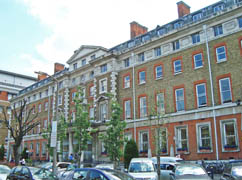
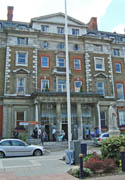
The Hambledon Wing, the original part of the Hospital on Bessemer Road, opened in 1913 (left). It is named after Lord Hambledon, who raised funds for the Hospital and enabled its move from Lincoln's Inn Fields. The main entrance (right).
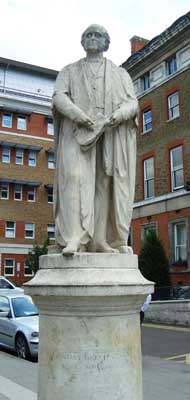
Robert Bentley Todd (1809-1860) was instrumental in establishing King's College Hospital in Portugal Street.
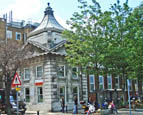
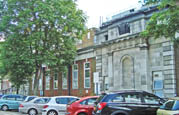
Once the building for the original Medical School, the Bessemer Wing is to the west of the Hambledon Wing.
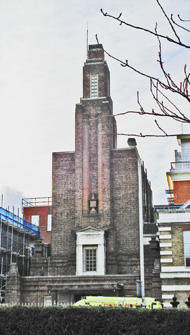
The Guthrie Wing, the private patients wing, built in 1937.
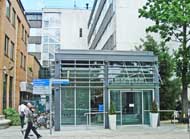
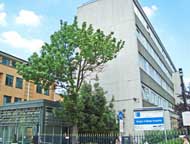
The Dental Institute, which was completed in 1965 and extended in 1991.
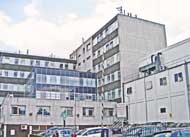
The back of the Dental Institute, as seen from Caldecot Road.
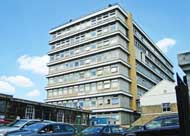
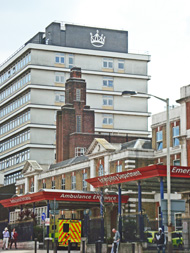
The Ruskin Wing opened in 1968 (left). The tower block - the tallest on the campus - looms over the Guthrie Clinic and the Denmark building (right).
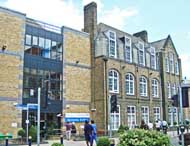
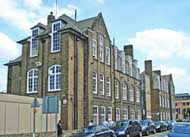
The Normanby Building is named after the 4th Marquess of Normanby (1912-1994), who was Chairman of the first Board of Governors, from 1948 until 1974.
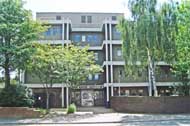
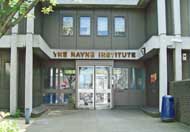
The Rayne Institute, which opened in 1979.
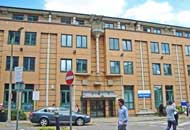
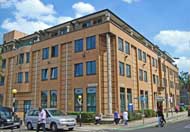
The Arthur Levin Building, the Day Surgery Centre, is named after Dr Arthur Levin who pioneered day surgery in England. He was involved in its planning during the 1980s.
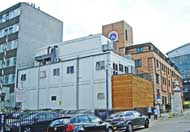
The back of the Arthur Levin building from Caldecot Road.
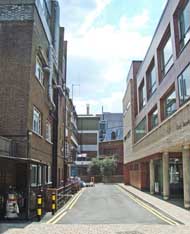
The Wellcome Clinical Investigation Unit (1990) at the end of the alley.
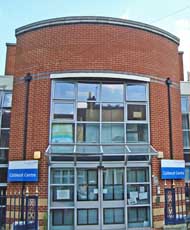
The main entrance to the Caldecot Centre.
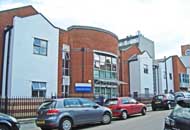
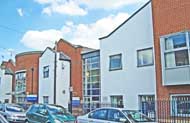
The Caldecot Centre at 15-22 Caldecot Road.
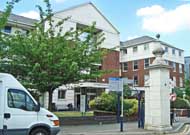
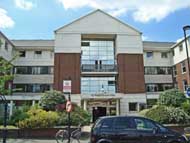
The Weston Education Centre opened in 1997.
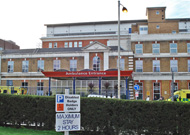
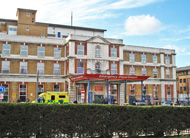
The Ambulance entrance (left) and the Accident and Emergency Department are located in the Denmark Wing, which also opened in 1997.
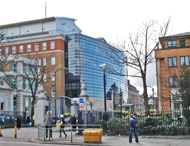
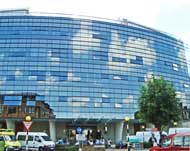
The mirror-glass southern elevation of the £60m Golden Jubilee Wing, located in Bessemer Road.
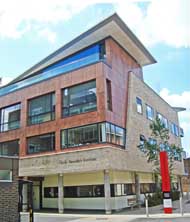
The Cicely Saunders Institute.
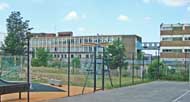
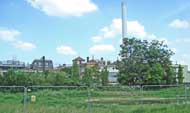
Looking across the railway lines to the south side of the present Hospital.
(Author unstated) 1910 King's College Hospital. British Medical Journal 1 (2558), 91-92.
(Author unstated) 1914 The reception of the wounded. The London Territorial Hospitals. British Medical Journal 2 (19th Sept), 517.
(Author unstated) 1916 War hospital magazines. Lancet 2, 453.
(Author unstated) 1917 List of the various hospitals treating military cases in the United Kingdom. London, H.M.S.O.
(Author unstated) 1936 Nursing echoes. British Journal of Nursing (March), 63.
http://en.wikipedia.org
www.kch.nhs.uk
www.kcl.ac.uk
www.nightingaleassociates.com
Return to home page